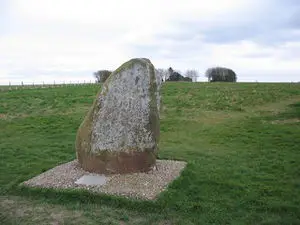How Historically Accurate is season 1 of The Last Kingdom
This article contains spoilers!!!!!
Check out our summaries for Season 2 and Season 3
The Last Kingdom is a popular television series recently released by the BBC and the show has strived to portray an accurate depiction of the time and reign of Alfred the Great. It is based on the Saxon Tales series written by Bernard Cornwell. The first season is drawn from the first two books in the series. The show focuses the life of Uhtred, son of Uhtred, who is a fictional character based on an amalgamation of several historical characters, during the Dane invasions of England during the 9th century. The events depicted in The Last Kingdom were critical early steps in forging what became England. The Last Kingdom is a reference to the Kingdom of Wessex, which was the last Anglo-Saxon kingdom to stand in the way of Dane conquest of England. Uhtred is from Bebbanburgh (modern Bamburgh), a part of Northumbria. The season begins with Uhtred's father being killed in a battle at York, where Uhtred was taken as a slave by the Danes. Uhtred's uncle then usurps the control of Bebbanburgh, where Uhtred was the rightful heir.
Anglo-Saxon and Danish History and Culture
The first episode focuses on the Danish characters, while they do act cruel to the Anglo-Saxons they are also fun loving and one of them, Earl Ragner, shows much affection to Uhtred. During the first episode, Uhtred's father and his army are slaughtered by the Danes soon after they arrive by sea. The first episode portrays the Anglo-Saxons as unprepared for war with the Danes and too dependent on their priests. There is some truth to this, the Anglo-Saxon army lacked professional warriors and the show states that the Danes believed the English were primarily farmers. In the first battle of the show, the Anglo-Saxons lost the battle because they were incapable of defeating a Danish shield wall. However, the Anglo-Saxon armies most likely were capable of properly forming a shield wall and they would not have been completely confounded by it. At this point, the Anglo-Saxons would have been well aware of Danish war tactics, even if they were not well prepared for them. The show ignored this reality because it allowed the lead character, Uhtred, to teach the Anglo-Saxons later in the season to both form and defeat a shield wall. In this case, historical accuracy was sacrificed to create a more compelling story.[1] The Last Kingdom has done a very credible job depicting Danes and Anglo-Saxons. While the Danes have often been called as Vikings, the show makes it clear that they were more than just Vikings. The Danes willingness to settle in England demonstrated that unlike actual Vikings, they did not want to survive simply by raiding. The Danish characters make it clear that they left Denmark because it was inhospitable to farming and there is truth to the fact that climatic events may have also contributed to increased Danish raids and invasions during this time.[2]
The Danes were not just savage in battle but showed more creativeness and ability to adapt to their new environment. The Anglo-Saxons could best be described as solemn, pious and fairly dreary. This difference results from the conflicting faiths of the Danes and Anglo-Saxons. The Danes at this time were polytheists and Anglo-Saxons were Christian. The series often depicts these cultural differences between the Danes and Anglo-Saxon and the resulting war between these societies as a broader conflict between the Christian faith and the Danish gods. This is certainly how Alfred described the struggle and there is historical accuracy, as also described by the Anglo-Saxon Chronicle, which is the primary historical source. The character of Uhtred is used to demonstrate this dichotomy. Uhtred, an Anglo-Saxon, prefers a company with the Danes, but he later swears an oath to Alfred, king of Wessex the last remaining Anglo-Saxon king.
The Danish beliefs did not involve a strict moral code like Christianity. At times, this loose moral code allowed the Danes to be more playful than the Anglo-Saxons, but this lack of moral code also has a dark side. In one scene, the Danes killed the East Anglian king, Edmund, with a volley of arrows after he was captured. The Danes were testing whether Edmund's god was as powerful as he claimed. [3] Not only did this event occur, but Edmund was canonized for it. Other Anglo-Saxon leaders are shown as tortured and murdered when captured. The Danes were fairly ruthless when they captured Anglo leaders, but the accurately depicts that some would be spared if they cooperated with the Danes and provided them with food, silver and land.
Many of the urban places are historical and the names used in the series reflects their Anglo-Saxon names. For instance, London and Reading are two cities mentioned. Wessex's primary town was Winchester (Figure 1), where most of the Wessex kings held court which is depicted in the series.[4] Winchester, in fact, was rival to London for a period as the capital of all of England.
Some of the terms used in the series were words prevalent at the time. This includes terms such as plowing a field having sexual connotations. Another term is arseling, used as a playful or sometimes mocking term of Uhtred by his friend Leofric, which also would have been a term used at the time meaning "from the ass."[5] Such terms and expressions were, in fact, contemporary to the period.
Key Battles
After the battle at York, several other key battles occur during the series. The first is the battle where Alfred's brother (Æthelred), who was the king of Wessex, dies, although the Anglo-Saxons are successful in temporarily halting the Danish advance. There is truth to Alfred's brother perhaps being injured and killed in battle as depicted in the series. Rather than the son of Æthelred taking power, it was Alfred that was chosen, something unexpected and discussed in the series, as he was seen as more fit to rule. This was done through the witan, which was a council that represented an early democratic selection process where they would choose who would rule as well as pass judgment on various affairs. The battle where Æthelred is fatally injured might be fictionalized or could be based on several battles where the Anglo-Saxons did have some success in limiting the Danish advances. Still, Wessex failed to stop the Danes completely and had to pay off the Danes for temporary peace. The show depicts the peace conference between King Alfred and Ubba. The character Ubba was a historical figure who did cause much trouble to the Anglo-Saxons.[6]
The next major encounter in the show was the Battle of Cynwit, which occurred in 878. The battle in the series depicts the Danes besieging Wessex's forces led by Odda the Elder. The Danish leader was Ubba, who was killed in the battle. The Danes had surrounded the Anglo-Saxon army on a hill and likely expected them to surrender, as they had little water, but the Wessex army attacked and was able to defeat the Danish army. The Raven banner was taken by the Anglo-Saxon army and it was a major battle in which the Wessex king Alfred did not lead. In the series, the year of the battle is different and the credit for killing Ubba went to Uhtred. However, as shown in the series, it was an important battle for the Wessex kingdom and Odda was the likely leader of Wessex during the battle, where the Anglo-Saxons did, in fact, pull off a surprising victory. In effect, it is likely that the Anglo-Saxons were encamped on the hill during the real battle and made a surprise attack on the Danes. This was a turning point as it now showed the Anglo-Saxons could fight major battles against the Danes and be victorious.[7]

The Danes also attacked in January 878 the town of Chippenham, which is where Alfred held his court at the time. The series diverges from reality and has the Danes attacking Winchester instead. The show had already established Winchester as the capital of Wessex and most likely sought to simplify the narrative instead of adding a new location for this battle. However, the attack did not occur there. The events, though, are generally accurate in that the Danes did attack in a surprising fashion at the height of winter, a period during when armies rested and did not launch invasions. Alfred was depicted as fleeing to the marshes of Somerset, where he was lucky to escape with his life. This was true and he did flee after the battle to hide from the Danes and he reorganized his forces in the swamps during the spring of that year.[8]
The next major encounter was the Battle of Edington (Figure 2), which pitted Guthrum of the Danes against Alfred. The Danes had likely assumed Alfred to be significantly weakened after being forced to flee. The battle was characterized by Alfred summoning his fyrds, or the popular army from different parts of his kingdom, that gathered to fight the Danes. This allowed Alfred to create a greater force and demonstrated he retained the loyalty of his ealdormen despite his earlier losses. Once again, the ability for the Saxons to muster a large force and launch an attack likely surprised the Danes. Egbert's stone was used as the meeting point for the fyrds in the series as well as in the chronicles describing the events. In effect, much of these events are true historically. The battle, unlike the series, involved an encounter of the armies where the Danes were driven into a fort and were besieged afterward. In the series, the main battle is only depicted as a pitched encounter and the siege was not shown.
In both cases, after Dane leader Guthrum was defeated and baptized, as a condition of the peace, the Danes led their remaining army away. Eventually, the Danes formed another kingdom called Danelaw that represented areas where the Danes ruled for nearly another 100 years. This was based on a treaty with Alfred, where areas north of Wessex and in East Anglia represented Danelaw. For some years, there was peace between Wessex and the Danes. Alfred, after this time, builds the boroughs, which were fortifications that helped protect Wessex. While relatively simple, these fortifications helped strengthen Wessex and made it more difficult for later Danish invasions. Although the invasions against Wessex continued, no serious threat ever occurred by Danish forces against Wessex.[9] Arguably, this was the battle that may have prevented all of England falling to Danish hands in the 9th century.
Historical Figures
There are a number of historical figures shown in the series on both the Danish and Anglo-Saxon sides. These include Ubba and Guthrum, who were fearsome Danish warlords, and Alfred (later known as Alfred the Great), Asser the Monk, and the ealdormen of Wessex, including Odda, who are royal officials and regional leaders in Wessex who supported Alfred in war. Other figures such as Ealhswith, Alfred's wife, and Edward, the son of Alfred, were also historical figures.[10]
Many of the personalities and depictions of the known historical figures are accurately presented in the series. For instance, Alfred's piety, digestive problems, and his penchant for women are likely to be true based on known accounts. Alfred, for instance, was rumored to have one illegitimate son, but the sources are not completely clear on this. Ubba, a Danish warlord, was known to be fearsome in battle. However, for the Danes, as historical accounts from their point of view are far fewer, we generally know less about them and sources tend to be biased against them. Wessex, on the other hand, was known to keep detailed historical records, as shown in the series. In fact, Alfred was known to have encouraged literacy throughout his kingdom.
While the main character Uhtred is not historical, he is based on Uhtred the Bold who lived after the events in the series in the 10th and 11th centuries. As the name suggests, Uhtred was known to have been a brave warrior. In the series, there is a feud between him and his uncle, who usurped the castle and territory of Bebbenburg (Bamburgh). After his adoptive Danish father is treacherously killed, Uhtred was forced to look to Alfred for assistance. This reflects some of the blood feud stories that did occur during and after the life of Uhtred, even though the events in the series did not outright occur. In effect, later stories were mixed with the period of the Anglo-Saxon wars with the Danes.[11]
Summary
Like many historical series and movies, there are a lot of untrue events and stories incorporated into the historical period depicted. However, the Last Kingdom does a very good job at incorporating many cultural elements that would have been contemporary at the time, including those involving the behavior of the characters and types of equipment they had during campaigns. Unlike many earlier historical dramas, this one looks more closely at the historical background of the characters, trying to imbue them in a cultural and historical context that would have been familiar to them but still entertaining to 21st-century viewers. The series informs us upon how England arose as a nation, where its origin emerges at a time when Anglo-Saxon England was threatened at its last English throne and was close to being taken by the Danes. The use of a lot of historical facts mixed with fictional events makes the series informative as well as entertaining.
Related DailyHistory.org Articles
- How Historically Accurate is the movie Gangs of New York?
- How Historically Accurate is the Outlaw King?
- How Historically Accurate is season 3 of The Last Kingdom?
- How historically accurate is the Medici Masters of Florence Series?
- Is the movie Dunkirk historically accurate?
- How historically accurate is the movie 'The Battle of the Bulge'?
- How historically accurate is the movie 'Tora, Tora, Tora'?
- How historically accurate is the movie 'A Bridge Too Far'?
- How Historically Accurate is Season 2 of Versailles?
- How accurate is the movie Patton?
- How accurate is Stanley Kubrick's 'Spartacus'?
- How Historically Accurate is Season 2 of Last Kingdom?
- How Historically Accurate is Alexander?
- How historically accurate is the Gladiator?
References
- ↑ For more on Anglo-Saxon fighting methods, see: Lavelle, R. (2010). Alfred’s wars: sources and interpretations of Anglo-Saxon warfare in the Viking age Woodbridge: The Boydell Press.
- ↑ For background on the Danes, see: Jones, G. (2001). A history of the Vikings (2nd ed). London ; New York: Oxford University Press.
- ↑ For more on Edmund, see: Pinner, R. (2015). The Cult of St Edmond in Medieval East Anglia. Woodbridge, UK: The Boydell Press.
- ↑ For more on Winchester in the Anglo-Saxon period, see: Legg, P. (2011). Winchester: history you can see. Stroud: History.
- ↑ For more on Anglo-Saxon terms, see: Baker, P. S. (2012). Introduction to Old English (3rd ed). Chichester, West Sussex ; Hoboken, N.J: Wiley.
- ↑ For more on Alfred, see: Smyth, A. P. (1995). King Alfred the Great. Oxford ; New York: Oxford University Press.
- ↑ For more on the Battle of Cynwit, see: Jones, G. (2001). A history of the Vikings (2nd ed). London ; New York: Oxford University Press, pg. 238.
- ↑ For more on Alfred's flight to the marshes of Somerset, see: Swanton, M. (Ed.). (2003). The Anglo-Saxon Chronicles (New ed., paperback rev. ed., 5. impr). London: Phoenix Press.
- ↑ For more on the Battle of Edington, see: Hunter Blair, P. H., & Keynes, S. (2006). An introduction to Anglo-Saxon England (3. ed., repr). Cambridge: Cambridge Univ. Press, pg. 111
- ↑ For more on the key historical characters from this period, see: Savage, Anne (1988).The Anglo-Saxon Chronicles Papermac.
- ↑ For more on Uhtred the Bold, see: James, J. (2013). An onslaught of spears: the Danish conquest of England.
Updated January 5, 2018
Admin, Maltaweel and EricLambrecht


